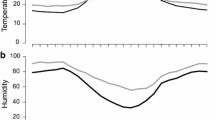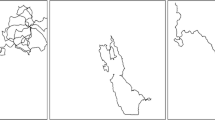Summary
Western harvester ants, Pogonomyrmex occidentalis, preferentially utilize low vegetational cover pathways. Energetic costs for foraging ants were less than 0.1% of caloric rewards of harvested seeds, suggesting that reduction of energetic cost is not a major benefit of this preference. Walking speed was significantly faster on lower cover routes, increasing net return rates from equidistant artificial food sources. Undisturbed foragers on low cover routes traveled farther, increasing their total foraging area without increasing foraging time. These results suggest that in animals with low costs of locomotion relative to energetic rewards, time costs are more important than direct energetic costs in influencing foraging decisions. In baited experiments with equidistant food sources, preferential use of low cover routes resulted in a large increase in net energetic gain rate, but only a slight increase in energetic efficiency. Under natural conditions, net energetic gain rates were constant for foragers using low and high vegetational cover routes, but foragers using low cover paths had lower efficiencies. This suggests that net energetic gain rate is a more important currency than energetic efficiency for foraging harvester ants.
Similar content being viewed by others
References
Bernstein RA (1982) Foraging-area size and food density: Some predictive models. Theor Pop Biol 22:309–323
Cosens D, Toussaint N (1985) An experimental study of the foraging strategy of the wood ant Formica aquilonia. Anim Behav 33:541–552
Davidson DW (1977) Species diversity and community organization in desert seed-eating ants. Ecology 58:711–724
Davidson DW (1978) Experimental tests of the optimal diet in two social insects. Behav Ecol Sociobiol 4:35–41
DeVita J (1979) Mechanisms of interference and foraging among colonies of the harvester ant Pogonomyrmex californicus in the Mojave desert. Ecology 60:729–731
Fewell JH (1988) Variation in the foraging patterns of the ant, Pogonomyrmex occidentalis in relation to variation in habitat structure. In: Jeanne RL (ed) Inter-individual variation in social insect behavior. Westview Press, Boulder, Colorado
Gendron RP, Staddon JER (1983) Searching for cryptic prey: The effect of search rate. Am Nat 121:172–186
Harrison JM (1986) Caste-specific changes in honeybee flight capacity. Physiol Zool 59:175–187
Harrison JS, Gentry JM (1981) Foraging pattern, colony distribution and foraging range of the Florida harvester ant, Pogonomyrmex badius. Ecology 62:1467–1473
Hebling Beraldo MJA, Mendes EG (1982) The influence of temperature on oxygen consumption rates of workers of two leaf cutting ants Atta laevigaata (F Smith 1858) and Atta sexdens ribripilosa (Forel 1908). Comp Biochem Physiol 71:419–424
Heinrich B (1972) Energetics of temperature regulation and foraging in a bumblebee, Bombus terricola Kirby. J Comp Physiol 77:40–64
Heinrich B (1975) Energetics of pollination. Ann Rev Ecol Syst 6:139–170
Heinrich B (1979) Bumblebee economics. Harvard Univ Press Cambridge, Mass
Holder Bailey A, Polis GA (1987) Optimal and central-place foraging theory applied to a desert harvester ant, Pogonomyrmex californicus. Oecologia (Berl) 72:440–448
Hölldobler B (1970) Steatoda fulva (Theridiidae), a spider that feeds on harvester ants. Psyche 77:202–208
Hölldobler B (1974) Home range orientation and territoriality in harvesting ants, Pogonomyrmex. Proc Natl Acad Sci USA 71:3271–3277
Hölldobler B (1976) Recruitment behavior, home range orientation and territoriality in harvester ants, Pogonomyrmex. Behav Ecol Sociobiol 1:3–44
Hölldobler B, Lumsden CJ (1980) Territorial strategies in ants. Science 210:732–739
Jensen TF, Holm-Jensen I (1980) Energetic cost of running in workers of three ant species, Formica fusca L, Formica rufa L, and Camponotus herculeanus L (Hymenoptera, Formicidae). J Comp Physiol 137:151–156
Jensen TF, Nielsen MG (1975) The influence of body size and temperature on worker ant respiration. Nat Jutlandica 18:21–25
Kelrick MI, MacMahon JA (1985) Nutritional and physical attributes of seeds of some common sagebrush-steppe plants: Some implications for ecological theory and management. J Range Manage 38:65–69
Kelrick MI, MacMahon JA, Parmenter RR, Sisson DV (1986) Native seed preferences of shrub-steppe rodents, birds and ants: The relationships of seed attributes and seed use. Oecologia (Berl) 68:327–337
Kendeigh SC, West GC (1965) Caloric values of plant seeds eaten by birds. Ecology 46:553–555
Lighton JRB, Bartholomew GA, Feener DH (1987) Energetics of locomotion and a model of the energy cost of foraging in the leaf-cutting ant Atta colombica Guer. Physiol Zool 60:524–537
Neilsen MG (1986) Respiratory rates of ants from different climatic areas. J Insect Physiol 32:125–131
Neilsen MG, Jensen TF, Holm-Jensen I (1982) Effect of load carriage on the respiratory metabolism of running worker ants of Camponotus herculeanus (Formicidae). Oikos 39:137–142
Pleasants JM (1981) Bumblebee response to variation in nectar availability. Ecology 62:1648–1661
Porter SD, Jorgensen CD (1981) Foragers of the harvester ant, Pogonomyrmex owyheei: A disposable caste? Behav Ecol Sobiobiol 9:247–256
Pyke GH (1978) Optimal foraging in bumblebees and coevolution with their plants. Oecologia (Berl) 36:281–293
Pyke GH (1980) Optimal foraging in bumblees: Calculation of net rate of energy intake and optimal patch choice. Theor Popul Biol 17:232–246
Pyke GH (1981) Optimal travel speeds of animals. Am Nat 118:475–487
Pyke GH (1984) Optimal foraging theory: A critical review. Ann Rev Ecol Syst 15:523–575
Pyke GH, Pulliam HR, Charnov EL (1977) Optimal foraging: A selective review of theory and tests. Quart Rev Biol 52:137–154
Rissing SW (1981) Prey preferences in the desert horned lizard: influence of prey foraging method and aggressive behavior. Ecology 62:1031–1040
Rissing SW, Pollack GB (1984) Worker size variability and foraging efficiency in Veromessor pergandei (Hymenoptera: Formicidae). Behav Ecol Sociobiol 15:121–126
Schmid-Hempel P, Kacelnik A, Houston AI (1985) Honeybees maximize efficiency by not filling their crop. Behav Ecol Sociobiol 17:61–66
Stephens D, Krebs J (1986) Foraging theory. Princeton Univ Press, Princeton, NJ
Taylor CR (1972) Running up and down hills: Some consequences of size. Science 178:1096–1097
Taylor F (1977) Foraging behavior of ants: Experiments with two species of Myrmecine ants. Behav Ecol Sociobiol 2:147–167
Traniello JFA (1977) Recruitment behavior, orientation, and the organization of foraging in the carpenter ant Camponotus pennsylvanicus DeGeer (Hymenoptera: Formicidae). Behav Ecol Sociobiol 2:65–68
Traniello JFA, Fujita MS, Bowen RV (1984) Ant foraging behavior: Ambient temperature influences prey selection. Behav Ecol Sociobiol 15:65–68
Vleck D (1978) The energetics of activity and growth: the energy cost of burrowing by pocket gophers and energy metabolism during growth and hatching of emu rhea and ostrich eggs. Ph D Dissertation, Univ Calif, Los Angeles
Waddington KD, Holden LR (1979) Optimal foraging: On flower selection by bees. Am Nat 114:179–196
Whitford WG (1978) Foraging in seed-harvester ants Pogonomyrmex spp. Ecology 59:185–189
Whitford WG, Bryant M (1979) Behavior of a predator and its prey: The horned lizard (Phrynosoma cornutum) and harvester ants (Pogonomyrmex spp). Ecology 60:686–694
Author information
Authors and Affiliations
Rights and permissions
About this article
Cite this article
Fewell, J.H. Energetic and time costs of foraging in harvester ants, Pogonomyrmex occidentalis . Behav Ecol Sociobiol 22, 401–408 (1988). https://doi.org/10.1007/BF00294977
Received:
Accepted:
Issue Date:
DOI: https://doi.org/10.1007/BF00294977




